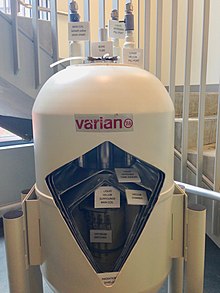 Global Information
Global InformationNuclear magnetic resonance spectroscopy information

Nuclear magnetic resonance spectroscopy, most commonly known as NMR spectroscopy or magnetic resonance spectroscopy (MRS), is a spectroscopic technique based on re-orientation of atomic nuclei with non-zero nuclear spins in an external magnetic field. This re-orientation occurs with absorption of electromagnetic radiation in the radio frequency region from roughly 4 to 900 MHz, which depends on the isotopic nature of the nucleus and increased proportionally to the strength of the external magnetic field .[1] Notably, the resonance frequency of each NMR-active nucleus depends on its chemical environment. As a result, NMR spectra provide information about individual functional groups present in the sample, as well as about connections between nearby nuclei in the same molecule. As the NMR spectra are unique or highly characteristic to individual compounds and functional groups, NMR spectroscopy is one of the most important methods to identify molecular structures, particularly of organic compounds.
The principle of NMR usually involves three sequential steps:
- The alignment (polarization) of the magnetic nuclear spins in an applied, constant magnetic field B0.
- The perturbation of this alignment of the nuclear spins by a weak oscillating magnetic field, usually referred to as a radio-frequency (RF) pulse.
- Detection and analysis of the electromagnetic waves emitted by the nuclei of the sample as a result of this perturbation.
Similarly, biochemists use NMR to identify proteins and other complex molecules. Besides identification, NMR spectroscopy provides detailed information about the structure, dynamics, reaction state, and chemical environment of molecules. The most common types of NMR are proton and carbon-13 NMR spectroscopy, but it is applicable to any kind of sample that contains nuclei possessing spin.
NMR spectra are unique, well-resolved, analytically tractable and often highly predictable for small molecules. Different functional groups are obviously distinguishable, and identical functional groups with differing neighboring substituents still give distinguishable signals. NMR has largely replaced traditional wet chemistry tests such as color reagents or typical chromatography for identification.
The most significant drawback of NMR spectroscopy is its poor sensitivity (compared to other analytical methods, such as mass spectrometry). Typically 2–50 mg, of a substance is required to record a decent quality NMR spectrum. The NMR method is non-destructive, thus the substance may be recovered. To obtain high-resolution NMR spectra, solid substances are usually dissolved to make liquid solutions, although solid-state NMR spectroscopy is also possible.
The timescale of NMR is relatively long, and thus it is not suitable for observing fast phenomena, producing only an averaged spectrum. Although large amounts of impurities do show on an NMR spectrum, better methods exist for detecting impurities, as NMR is inherently not very sensitive - though at higher frequencies, sensitivity is higher.
Correlation spectroscopy is a development of ordinary NMR. In two-dimensional NMR, the emission is centered around a single frequency, and correlated resonances are observed. This allows identifying the neighboring substituents of the observed functional group, allowing unambiguous identification of the resonances. There are also more complex 3D and 4D methods and a variety of methods designed to suppress or amplify particular types of resonances. In nuclear Overhauser effect (NOE) spectroscopy, the relaxation of the resonances is observed. As NOE depends on the proximity of the nuclei, quantifying the NOE for each nucleus allows for construction of a three-dimensional model of the molecule.

NMR spectrometers are relatively expensive; universities usually have them, but they are less common in private companies. Between 2000 and 2015, an NMR spectrometer cost around 500,000 - 5 million USD.[3][4] Modern NMR spectrometers have a very strong, large and expensive liquid helium-cooled superconducting magnet, because resolution directly depends on magnetic field strength. Higher magnetic field also improves the sensitivity of the NMR spectroscopy, which depends on the population difference between the two nuclear levels, which increases exponentially with the magnetic field strength.
Less expensive machines using permanent magnets and lower resolution are also available, which still give sufficient performance for certain applications such as reaction monitoring and quick checking of samples. There are even benchtop nuclear magnetic resonance spectrometers. NMR spectra of protons (1H nuclei) can be observed even in Earth magnetic field. Low-resolution NMR produces broader peaks which can easily overlap one another causing issues in resolving complex structures. The use of higher strength magnetic fields result in a better sensitivity and higher resolution of the peaks, and it is preferred for research purposes.[5]
- ^ Charles P. Slichter (1963). Principles of magnetic resonance: with examples from solid state physics. Harper & Row. ISBN 9783540084761.
- ^ Structural biology : practical NMR applications (PDF) (2nd ed.). Springer. 6 September 2012. p. 67. ISBN 978-1-4614-3964-6. Retrieved 7 December 2018.
- ^ Marc S. Reisch (June 29, 2015). "NMR Instrument Price Hikes Spook Users". CEN.
- ^ "Taking It Higher". The Scientist. Oct 30, 2000.
- ^ Paudler, William (1974). Nuclear Magnetic Resonance. Boston: Allyn and Bacon Chemistry Series. pp. 9–11.